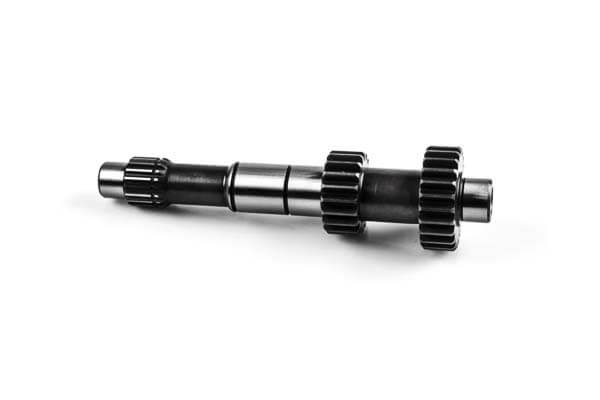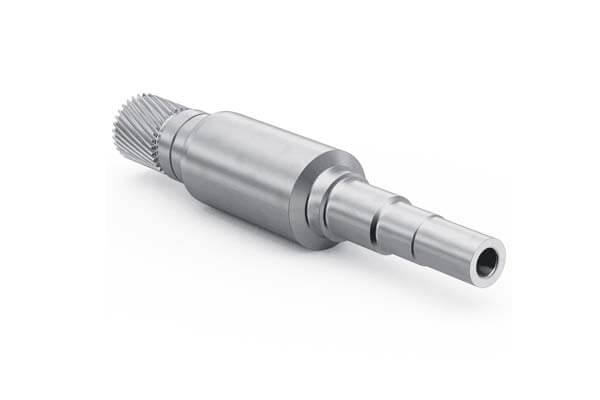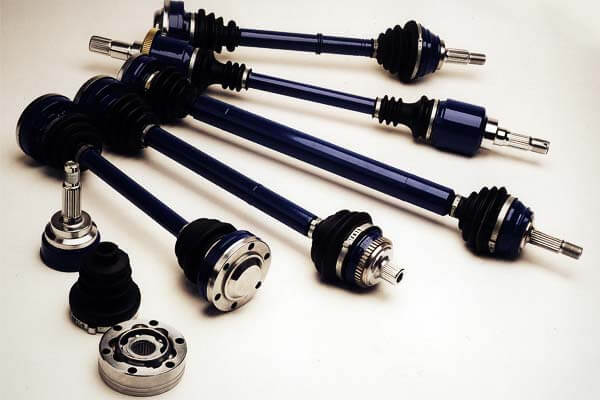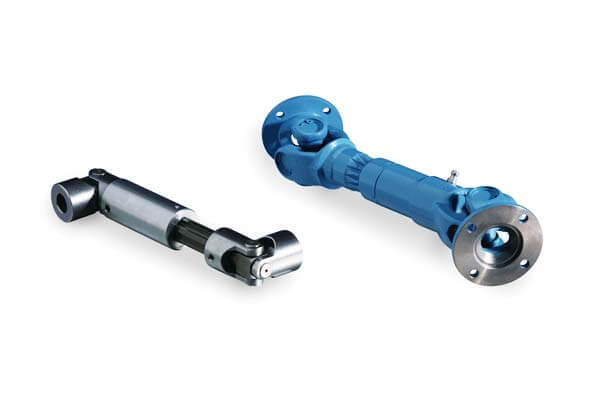1. Įvadas
Transmission shafts are at the heart of mechanical systems that require efficient power transfer.
These components are integral to transferring rotational power and torque from one part of a machine to another, ensuring smooth and effective operation.
Transmission shafts play a critical role in maintaining system efficiency and performance in automotive engines, pramoninės mašinos, or aerospace applications.
Šiame tinklaraštyje, we’ll dive into the different types of transmission shafts, the materials used in their construction, the manufacturing processes, and their applications across various industries.
2. What is a Transmission Shaft?
A transmission shaft is a mechanical component designed to transfer rotational power between different parts of a system.
It typically connects motors or engines to components that require power, such as wheels, sraigtai, or conveyor belts.
By transmitting torque, these shafts enable the system to operate by converting energy from one part of the machine to another.

Transmission shafts are indispensable in numerous applications.
Pavyzdžiui, automotive engines, transfer power from the engine to the wheels. In industrial machinery, they are used to connect motors to various moving parts.
Without transmission shafts, machines would be unable to transfer energy effectively, causing system failure or inefficient operation.
Key Components of a Transmission Shaft Include:
- Shaft Body: The primary cylindrical structure that transmits torque.
- Keyways & Splines: These features ensure secure connections to other components.
- Guoliai: Support the shaft and reduce friction.
- Couplings: Facilitate torque transmission between connected parts.
3. Types of Transmission Shafts
Transmission shafts come in various types, each designed to suit specific applications and requirements.
The key to choosing the right shaft lies in understanding the system’s power requirements, the distance the power needs to travel, and the mechanical stresses the shaft will endure.
Single-Piece Shafts
Apibrėžimas: As the name suggests, single-piece shafts are made from a single continuous section of material.
They are typically used in applications where high-power transmission or extreme strength isn’t required.

Paraiškos:
- Used in simpler, smaller machinery or systems where space or weight constraints aren’t as critical.
- Common in home appliances, light machinery, and low-torque systems.
Privalumai:
- Simple design with fewer parts, which means they are easy to manufacture and cost-effective.
- Ideal for short-distance power transmission where precision and strength requirements are moderate.
Apribojimai:
- Limited to low- or medium-power applications.
- Not ideal for systems requiring high durability or torque handling.
Multi-Piece Shafts
Apibrėžimas: Multi-piece shafts consist of several sections of shaft components joined together, typically by couplings, flanšai, or other mechanical connectors.
They are used in systems that require longer shafts or more complex setups.

Paraiškos:
- Often found in larger machines, industrial equipment, and systems requiring longer distances between power sources and endpoints.
- Used in heavy-duty vehicles, construction machinery, and certain industrial conveyor systems.
Privalumai:
- Versatile and adaptable to a variety of system configurations.
- Easier to replace or modify individual sections of the shaft without replacing the entire unit.
- More suitable for long-distance power transmission than single-piece shafts.
Apribojimai:
- More complex to design and manufacture due to the need for connectors between shaft sections.
- Potential for additional wear at the connecting points between sections.
Constant Velocity (CV) Velenai
Apibrėžimas: Constant velocity (CV) shafts are designed to maintain consistent rotational speed and torque, even when the angle of the shaft changes during operation.
These shafts use universal joints to ensure smooth power transmission despite angular variations.

Paraiškos:
- Predominantly used in the automotive industry, especially in front-wheel drive and all-wheel drive vehicles.
- Also found in machinery and systems where the angle of rotation changes, such as suspension systems in vehicles.
Privalumai:
- Smooth power delivery at varying angles, which reduces vibration and wear.
- Allows for higher torque transfer without sacrificing rotational speed.
- Essential for maintaining efficient operation in complex drive systems.
Apribojimai:
- More expensive to manufacture compared to traditional shafts due to the need for universal joints.
- The complexity of the design makes it less suitable for simpler systems.
Drive Shafts
Apibrėžimas: Drive shafts are crucial components in transferring rotational power from a motor or engine to other parts of a machine, such as wheels, pavaros, or other driven components.
Drive shafts are designed to handle high torque and are critical in various applications.

Paraiškos:
- Automobiliai: Drive shafts are used to transfer power from the engine to the wheels in vehicles.
- Pramoninės mašinos: Found in large machinery like conveyors, mills, ir apdorojimo įranga.
Privalumai:
- Highly efficient at transmitting power over long distances.
- Typically designed to handle high torque, ensuring reliable performance in demanding environments.
Apribojimai:
- Heavy-duty driveshafts require robust design and materials, often making them heavier and more expensive.
- Vulnerable to bending or twisting if not properly aligned.
Propeller Shafts
Apibrėžimas: Propeller shafts are a specialized type of drive shaft used to transfer power from engines to the propeller in marine vessels, orlaivis, and other similar applications.
Paraiškos:
- Jūrų pramonė: Propeller shafts are used in boats and ships to transmit power from the engine to the propeller for movement.
- Aviacijos ir kosmoso: In aircraft, propeller shafts connect engines to propellers or other rotating components.
Privalumai:
- Allows for efficient propulsion in both water and air, ensuring smooth and continuous motion.
- Can be designed to handle high rotational speeds and large amounts of torque.
Apribojimai:
- Vulnerable to corrosion, especially in marine environments, requiring advanced coatings or material choices such as stainless steel.
- Typically requires regular maintenance and inspection to prevent failure due to wear.
Cardan Shafts
Apibrėžimas: A Cardan shaft is a type of universal joint shaft used to transmit torque between two non-aligned components,
allowing for smooth operation even when the connected parts are at different angles.
Cardan shafts are commonly used where there is a need for flexibility in power transmission.

Paraiškos:
- Automobiliai: Often used in off-road vehicles, heavy-duty trucks, and military vehicles to transmit power to parts that are not in a straight line with the motor.
- Pramoninis: Found in various machinery and power transmission systems that require flexibility and angular adjustments.
Privalumai:
- Provides flexibility in non-linear configurations, allowing for smoother power transfer even when parts are not perfectly aligned.
- Essential for heavy-duty and off-road applications where traditional straight shafts would not work.
Apribojimai:
- Complex design requiring careful balancing and alignment.
- Can be prone to wear if not properly maintained or aligned.
Idler Shafts
Apibrėžimas: Idler shafts do not directly transmit power; vietoj to, they support other rotating components within a mechanical system.
They are used to guide, support, or stabilize other shafts, typically in systems where multiple rotating elements are present.
Paraiškos:
- Conveyors: In manufacturing plants and warehouses, idler shafts help guide and support conveyor belts.
- Automobiliai: Used in various drivetrain components to support or adjust the positioning of other rotating parts.
Privalumai:
- Paprastas dizainas, often serving a supporting or guiding role rather than power transmission.
- Essential for the smooth operation of systems with multiple shafts.
Apribojimai:
- While they provide support, idler shafts do not carry much load or transfer power directly, limiting their application in power-critical systems.
4. Materials Used for Transmission Shafts
The material chosen for a transmission shaft plays a critical role in determining its performance, patvarumas, and overall lifespan.
Transmission shafts are subjected to high levels of mechanical stress, including torque, lenkimas, and vibration.
Todėl, selecting the right material is key to ensuring the shaft performs reliably in its intended application.
Plienas
Steel is the most widely used material for transmission shafts due to its excellent combination of strength, patvarumas, ir universalumas.
Various types of steel, such as carbon steel, lydinio plienas, ir nerūdijančio plieno, are used depending on the specific demands of the application.
Privalumai:
- Strength and Toughness: Steel can withstand high torque and mechanical stress, making it ideal for heavy-duty applications.
- Ekonominis efektyvumas: Steel is relatively inexpensive compared to more advanced materials, making it a popular choice for a wide range of industries.
- Malleability: Steel can be heat-treated, forged, or machined to meet specific requirements, such as increased hardness or flexibility.
- Gamybos paprastumas: Steel shafts can be easily manufactured and modified through standard machining processes, allowing for cost-effective production.
Apribojimai:
- Atsparumas korozijai: While steel is highly durable, it can be prone to corrosion unless properly coated or alloyed (Pvz., with chromium or nickel).
- Svoris: Steel can be heavy, which may not be ideal for weight-sensitive applications.
Lydinio plienas
Alloy steels are steel alloys that contain additional elements such as chromium, molibdenas, vanadium, and nickel.
These alloys provide enhanced strength, atsparumas nusidėvėjimui, and heat resistance, making them ideal for high-performance applications.
Privalumai:
- Enhanced Strength: Alloy steels can handle higher torque and stress compared to standard carbon steels.
- Atsparumas nusidėvėjimui: The added alloys provide better resistance to wear, making them suitable for high-demand applications.
- Šilumos atsparumas: Certain alloy steels can withstand elevated temperatures, which is beneficial for applications where heat is generated during operation.
Apribojimai:
- Kaina: Alloy steels are typically more expensive than plain carbon steels due to the added alloying elements.
- Machining Difficulty: Some alloy steels can be harder to machine, requiring specialized equipment or techniques.
Nerūdijantis plienas
Stainless steel is a corrosion-resistant alloy made primarily of iron, Chromas, and small amounts of other elements like nickel and molybdenum.
It is commonly used for shafts in environments that require both strength and resistance to corrosion.
Privalumai:
- Atsparumas korozijai: Stainless steel’s ability to resist rust and corrosion makes it ideal for harsh environments.
- Patvarumas: Stainless steel shafts can last longer, even under continuous exposure to moisture and chemicals.
- Aesthetic Appeal: Stainless steel has a shiny, Lygus apdaila, which can be desirable in applications where appearance matters.
Apribojimai:
- Lower Strength: Stainless steel is typically not as strong as some alloy steels, which may limit its use in extremely high-torque or high-stress applications.
- Kaina: Stainless steel is more expensive than carbon steel, making it a more costly option for many applications.
Carbon Fiber
Apibrėžimas: Carbon fiber is a composite material made from carbon filaments and polymer resin.
It is a lightweight, high-strength material that has gained popularity in modern engineering, particularly in industries that require shafts with low weight and high performance.
Privalumai:
- Lengvas: Carbon fiber is significantly lighter than metal, which reduces the overall weight of the system and improves fuel efficiency or performance.
- Didelis stiprumo ir svorio santykis: Despite its low weight, carbon fiber is extremely strong and can handle high torsional loads.
- Atsparumas korozijai: Carbon fiber does not corrode, making it suitable for harsh environments.
Apribojimai:
- Kaina: Carbon fiber is more expensive than traditional metals, making it impractical for some applications.
- Trapumas: While strong, carbon fiber is more brittle than metal, which can make it prone to cracking under certain stress conditions.
Titano lydiniai
Apibrėžimas: Titanium alloys are lightweight, high-strength materials that are often used in applications where both performance and corrosion resistance are required.
They combine titanium with other elements such as aluminum, vanadium, or molybdenum.
Privalumai:
- Lightweight and Strong: Titanium offers a superior strength-to-weight ratio, making it ideal for aerospace and performance applications.
- Atsparumas korozijai: Titanium is highly resistant to corrosion, Ypač jūrų ir cheminėje aplinkoje.
- Patvarumas: Titanium alloys can endure high temperatures and stress, padaryti juos tinkamus reikalauti pramonės programų.
Apribojimai:
- Kaina: Titanium is one of the most expensive materials used for transmission shafts.
- Machining Difficulty: Titanium is difficult to machine, often requiring specialized equipment and processes.
Aliuminis
Apibrėžimas: Aluminum is a lightweight metal known for its corrosion resistance and ease of machining.
While not as strong as steel, it is used for shafts in applications where reducing weight is a priority.
Privalumai:
- Lengvas: Aluminum’s low density makes it ideal for applications where weight reduction is important.
- Atsparumas korozijai: Aluminum’s natural oxide layer protects it from corrosion, making it suitable for outdoor and marine applications.
- Aparatas: Aluminum is relatively easy to machine, reducing manufacturing time and cost.
Apribojimai:
- Lower Strength: Aluminum is not as strong as steel or titanium, which limits its use in high-stress applications.
- Atsparumas nusidėvėjimui: Aluminum can wear down more quickly than steel, especially in high-friction applications.
5. Manufacturing Process of Transmission Shafts
The manufacturing process for transmission shafts is a meticulous and multi-step procedure designed to ensure the highest standards of strength, Tikslumas, ir patvarumas.
Each phase from material selection to final finishing plays a crucial role in determining the performance and longevity of the shafts.
Kalimas
Forging involves shaping metal through high-pressure compression.
This step is critical as it enhances the grain structure of the metal, improving its mechanical properties such as tensile strength and fatigue resistance.
Paprastai, blanks or billets are heated to a specific temperature before being forged into rough shapes that resemble the final product.
For heavy-duty applications, this process can increase the tensile strength of the shaft up to 1,200 MPA, ensuring it can withstand significant loads without deformation.
Apdirbimas
Once the forging process is complete, the rough-formed shaft undergoes machining.
Precision processes like turning, frezavimas, and grinding refine the shaft to meet exact specifications.
Advanced CNC machines can achieve tolerances as tight as ±0.01 mm, which is essential for ensuring smooth operation and minimal vibration in high-speed systems.
During this stage, features such as splines, Siūlai, and bearing surfaces are machined onto the shaft to fit specific application requirements.
Terminis apdorojimas
Heat treatment is a pivotal step that further enhances the mechanical properties of the shafts. Techniques such as tempering and hardening improve hardness and wear resistance.
Pavyzdžiui, heat treatment can increase the surface hardness of the shaft up to 60 HRC, significantly enhancing its durability.
This process also helps relieve internal stresses induced during previous manufacturing steps, reducing the likelihood of cracking or failure under operational loads.
Paviršiaus procedūros
To protect against wear and corrosion, surface treatments like nitriding or chrome plating are applied.
These treatments not only extend the service life of the shaft but also reduce friction, leading to smoother operation.
Nitrided surfaces, pavyzdžiui, can last up to three times longer than untreated ones, making them particularly suitable for harsh environments where corrosion is a concern.
Chrome plating adds a layer of chromium to the surface, providing excellent wear resistance and a low friction coefficient.
6. Key Features and Considerations for Transmission Shafts
When designing transmission shafts, several factors must be taken into account to ensure optimal performance:
- Torque Capacity: The shaft must be able to handle the required torque without failure. This is influenced by material choice, shaft diameter, and overall design.
- Stiprybė & Patvarumas: Strong materials and precise manufacturing are necessary to ensure that the shaft can withstand the demands of the system.
Factors like shaft diameter and material composition impact its overall strength. - Tikslumas: High-speed systems, such as those in aerospace or automotive applications, require shafts with tight tolerances to ensure smooth operation and minimal vibration.
- Atsparumas korozijai: For applications in harsh environments, corrosion resistance is critical.
Stainless steel or coated shafts are often used in marine or food processing systems, where exposure to moisture or chemicals is a concern.
7. Common Applications of Transmission Shafts
Transmission shafts are used across various industries, each with specific needs and challenges:
Automobilių pramonė
Transmission shafts, including drive shafts and CV shafts, are vital components in vehicles, transmitting power from the engine to the wheels and ensuring smooth operation.
The global automotive industry produces over 70 million vehicles annually, with millions of shafts used in production each year.
Aviacijos ir kosmoso pramonė
In aerospace applications, shafts such as turbine shafts and gearbox shafts are used to transmit power from the engine to the aircraft’s propulsion system.
With the aerospace market projected to reach over $1 trillion by 2035, the demand for high-quality shafts continues to grow.
Marine Applications
In marine vessels, propeller shafts transfer power from the engine to the propeller, ensuring effective propulsion.
With an estimated global shipbuilding industry value of $175 billion, propeller shafts play a pivotal role in the maritime industry.
Pramoninės mašinos
In factories and processing plants, shafts are used to connect motors to conveyor belts, assembly lines, and other machinery.
These systems require precision shafts to ensure efficient production.
Agricultural Equipment
Shafts in agricultural machinery, such as tractors and harvesters, are essential for transmitting power to various rotating tools.
As the global demand for food rises, agricultural equipment manufacturers rely on robust shafts for reliable power transfer.
8. Challenges in Transmission Shaft Design
Designing transmission shafts involves overcoming several technical challenges to ensure reliability, patvarumas, and efficiency under varying operational conditions.
These challenges range from managing material fatigue and wear to ensuring proper balancing and alignment, all while optimizing design for performance and cost.
Fatigue and Wear
One of the primary challenges in designing transmission shafts is addressing fatigue and wear.
Shafts operate under cyclic loading, which can lead to fatigue failure over time if not properly managed.
Pavyzdžiui, in automotive applications, drive shafts may experience torque loads that fluctuate between 100 Nm and 500 Nm or more depending on driving conditions.
To mitigate this risk, engineers must select materials with high fatigue strength and incorporate design features such as fillets and transitions that reduce stress concentrations.
Be to, surface treatments like nitriding or induction hardening can enhance the wear resistance of the shaft, extending its service life.
Švelninimo strategijos:
- Utilize advanced materials like alloy steel or stainless steel that offer superior fatigue resistance.
- Implement design practices that minimize stress concentrations, such as using generous radii at changes in cross-section.
- Apply surface treatments to improve wear resistance.
Balancing and Alignment
Proper balancing and alignment are crucial for preventing vibrations and ensuring smooth operation.
Misalignment can cause uneven wear on bearings and seals, leading to premature failure.
In high-speed applications, even slight imbalances can result in excessive vibration, triukšmas, ir sumažėjęs efektyvumas.
Pavyzdžiui, a small imbalance in a shaft rotating at 3,000 RPM could generate forces up to 100 times greater than gravity, significantly impacting performance and safety.
Švelninimo strategijos:
- Use precision manufacturing techniques to achieve tight tolerances, typically within ±0.01 mm.
- Employ dynamic balancing techniques to correct any imbalances before installation.
- Ensure proper alignment during assembly and maintenance phases by using laser alignment tools.
Design Optimization
Optimizing the design of transmission shafts to balance performance, svoris, and cost without compromising on strength or reliability presents another challenge.
Lightweight materials like carbon fiber composites can reduce weight by up to 40% compared to traditional metals, but they come at a higher cost.
Be to, reducing weight must be carefully balanced against maintaining necessary strength and durability,
especially in heavy-duty applications where shafts might need to handle torques exceeding 1,500 Nm.
Švelninimo strategijos:
- Conduct finite element analysis (Fea) to simulate different load scenarios and optimize designs accordingly.
- Explore hybrid designs combining traditional metals with lightweight materials to find an optimal balance.
- Consider modular designs that allow for easier customization and repair, potentially lowering long-term costs.
Environmental Factors
Environmental factors such as exposure to moisture, Chemikalai, and extreme temperatures also pose significant challenges.
In marine environments, pavyzdžiui, corrosion is a major concern due to constant exposure to saltwater.
Stainless steel or specialized coatings are often required to protect against corrosion, though these solutions add to the overall cost and complexity of the design.
Švelninimo strategijos:
- Select materials resistant to specific environmental conditions, such as stainless steel for corrosive environments.
- Apply protective coatings or surface treatments like chrome plating or epoxy paints to enhance corrosion resistance.
- Incorporate design features that facilitate easy inspection and maintenance, allowing for prompt intervention when issues arise.
9. Išvada
Transmission shafts are essential components in the mechanical systems of various industries, ensuring the effective transfer of power and torque.
Whether you are looking for shafts for automotive, aviacijos ir kosmoso, Jūrų, or industrial applications by understanding the types, Medžiagos, and manufacturing processes involved,
engineers can continue to innovate and improve these critical components, ensuring they meet the evolving demands of modern industries.
If you’re looking for high-quality transmission shafts, choosing Tai is the perfect decision for your manufacturing needs.



